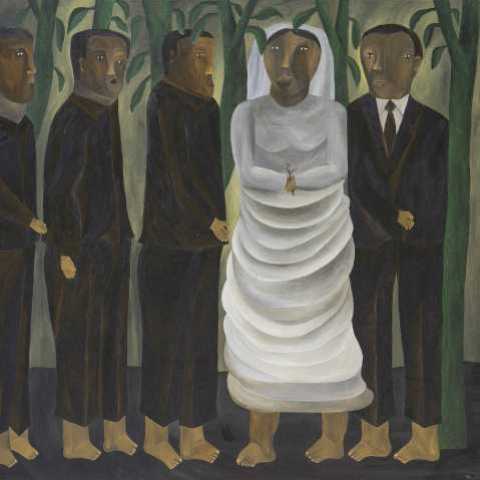Saatchi Gallery
King's Road
London
SW3 4SQ
United Kingdom

SALON, in collaboration with Roubi L’Roubi, is delighted to present Forests and Spirits: Figurative art from the Khartoum School, an exhibition of recent works by Sudanese artists Salah Elmur, Kamala Ishaq and Ibrahim El-Salahi.
Opening on 28 September, the show is comprised of 14 medium and large-scale paintings – 9 by Elmur and 5 by Ishaq – and a single sculpture, Meditation Tree (2018), by El-Salahi †.
Conceived by Roubi L’Roubi, curator of the Foundation Gallery, and Philippa Adams, Saatchi Gallery’s Director, Forests and Spirits seeks to bring wider attention to contemporary African art, and in particular the enduring influence of the Khartoum School. Formed in 1960 by Ishaq, El-Salahi and Ahmed Shibrain, the Khartoum School was an art movement centred around the city’s College of Fine and Applied Arts, the institution which has itself been pivotal in the development of contemporary art in Africa. All three artists studied there; indeed, Elmur was a pupil in the 1980s when Ishaq, a former graduate, was head of painting.
In this landmark presentation, Ishaq and Elmur’s paintings will be displayed around El-Salahi’s Meditation Tree. His first sculpture, the work fulfils the artist’s long-held ambition to render his drawn images in three dimensions and to play with their scale. The work, part of his ‘Tree’ series, was inspired by the characteristics of a particular type of acacia tree called Haraz. Indigenous to Sudan, the Haraz is of great cultural, spiritual and economical significance – the country’s largest export, gum Arabic, is harvested from it. Part of the artist’s ongoing emphasis on the spiritual in his work, Salahi’s trees can be seen as a type of self-portrait, formed from his investigation of the tree/body metaphor as a link between heaven and earth, creator and created.
Trees are a recurring trope in Elmur’s work. Many of the paintings featured in this show are drawn from his celebrated ‘Forest’ series, first seen in his acclaimed 2018 retrospective at the Sharjah Art Museum, UAE. These were inspired by the Sunut Forest, which lies on the junction of the White Nile and Blue Nile at the centre of Khartoum. It is a place where people come to celebrate and picnic. The Bride and Queue of Admirers (2017) captures one such occasion. Four besuited male figures stand around a female in a white dress. Behind them are six green-barked trees. The man on the right, presumably the groom, appears pleased and complaisant, while the others peer enviously at his prize. As with many of his paintings, it exudes intrigue and mystery, asking questions but providing no answers.
Ishaq, meanwhile, has long been preoccupied with the cult of Zar, the term for a demon or spirit assumed to possess individuals, mostly women. The ceremony to drive them away is not an exorcism as perceived by Western sensibilities, it typically includes music and dancing and is effectively an exercise in social restraint, as the ‘demon’ is often nothing more than an undesirable personality trait such as rudeness or licentiousness.
In Preparation of Incense (2015), Ishaq summons her vision of Zar. Thirteen female figures appear as spirits apparently ascending into the heavens. Various swirling plants convey the sense of movement; these dart left and right like shoals of fish, but also grow from the subjects’ mouths, which are agape – possibly wailing, revealing rows of harrowing, broken teeth.
In contrast, Elmur’s paintings are models of constraint. His subjects sit or stand motionless like they are presenting themselves to a camera for an official portrait. This echoes his father and grandfather’s association with photography. For many years they ran a studio in Khartoum and while it closed before he was born, the artist was fascinated by the portraits that were arranged around his family home.
Elmur’s work chronicles the quotidian, capturing the people of Khartoum at play, in domestic settings and at work. His paintings present no discernible narrative. His subjects might hold a plant in their hand, or a musical instrument, an animal or a child, but if they symbolise anything the viewer is left to develop their own thoughts.
Says curator L’Roubi: ‘At a time of great interest in African art, it is a special privilege to bring these three unique talents together, and in particular to place the spotlight on Kamala Ishaq, one of three founders of the Khartoum School and a seminal figure in the development of modern and contemporary African art.
‘Like El-Salahi, both Ishaq and Elmur draw on older traditions for inspiration – Ishaq with the ceremony of Zar and Elmur, in the works presented here, on the delicate interplay between nature and humanity, the spiritual and the temporal, a line of investigation that unites the practices of all three artists.’
Says Philippa Adams, Director, Saatchi Gallery: ‘We are delighted to be showing works by these three distinguished artists of the Khartoum School, in an exhibition that reveals the unique contribution each has made to the development of African art.’
Image Credit: Salah Elmur, The Bride and Queue of Admirers, 2017, Acrylic on Canvas, 200 x 185 cm, Courtesy of the Artist
